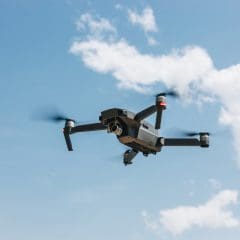Using drones for squirrel, bee, or bird surveys to locate pest entry points, such as holes or nests, offers several significant advantages over traditional methods like using ladders. These advantages include safety, efficiency, and effectiveness:
1. Safety
Reduced Risk of Falls: Climbing ladders poses a significant risk of falls, especially when inspecting hard-to-reach areas such as rooftops, eaves, or tall trees. Drones eliminate the need for ladders, thereby reducing the risk of injury.
Avoiding Dangerous Encounters: Approaching a live bees’ nest or other aggressive pests can be hazardous. Drones allow inspectors to maintain a safe distance while still getting a close-up view, minimizing the risk of stings or attacks.
2. Efficiency
Time-Saving: Drones can cover large areas quickly and reach difficult spots without the need for setup or repositioning, which is required with ladders. This efficiency speeds up the survey process significantly.
Access to Inaccessible Areas: Drones can easily navigate to areas that are difficult or impossible to reach with a ladder, such as high roofs, tight spaces, or over obstacles.
3. Effectiveness
High-Resolution Imaging: Modern drones are equipped with high-resolution cameras that can capture detailed images and videos, making it easier to identify small holes or entry points that might be missed from the ground.
Thermal Imaging: Some drones come with thermal imaging capabilities, which can detect heat signatures from nests or clusters of pests, providing an additional tool for locating entry points that are not visible to the naked eye.
Data Collection and Analysis: Drones can be used to collect data systematically and repeatedly, allowing for better tracking and analysis of pest activity over time. This data can be reviewed and analyzed to determine the best course of action for pest control.
Overall, drones provide a safer, more efficient, and often more accurate method for locating pest entry points compared to traditional ladder-based inspections. This technology enhances the ability to manage and control pest issues effectively while ensuring the safety of the inspectors.











